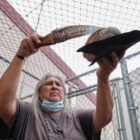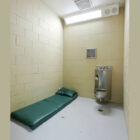
Human rights group urges resentencing of tens of thousands who, convicted in their teens, have spent decades behind bars
|
While locked in a California prison for juveniles, Paul Bocenegra got his first shave, sprouted his first patch of chest hair and, he said, learned to fight at that facility, dubbed "gladiator school" because of its levels of violence. "I was condemned to prison to die in a cage at 17 years old," said Bocanegra, now 48, who was tried as an adult in 1992 and served 25 years of what was supposed to be a life-without-parole prison sentence.








